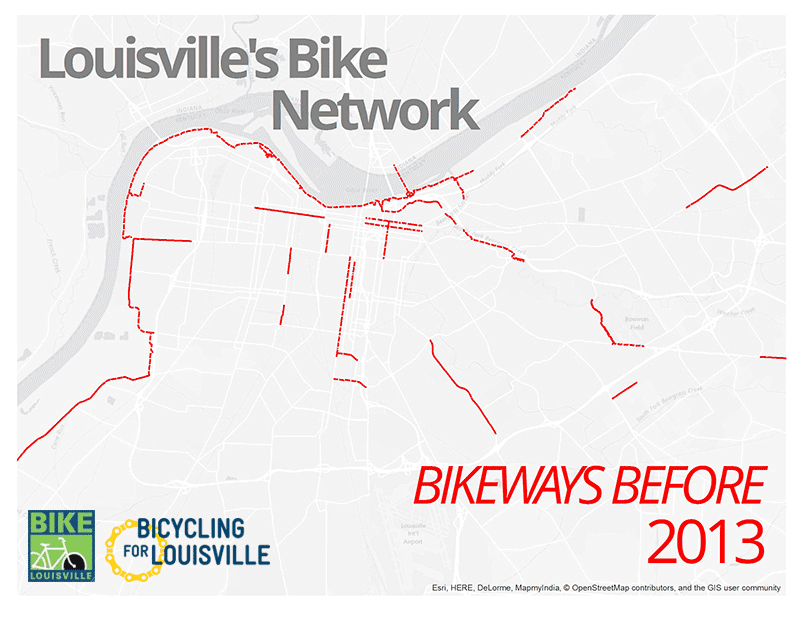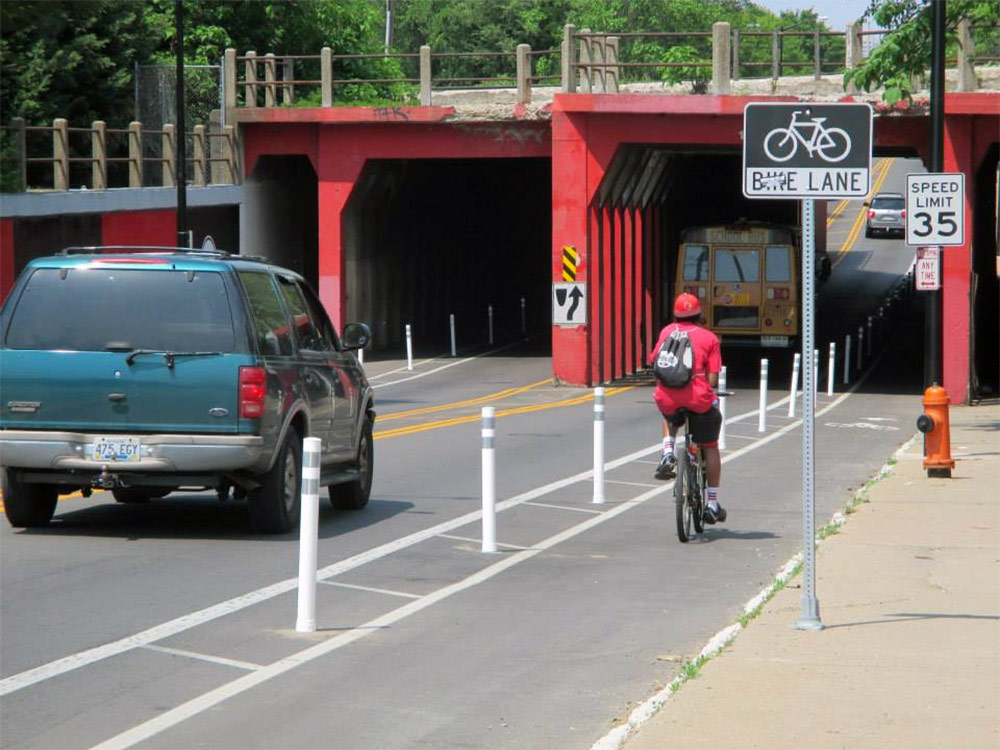
Until now, Louisville’s Urban Bike Network (UBN) meant more on paper than on pavement—but that’s changing fast. “The bike lanes in town didn’t make up a network until the past few years,” Chris Glasser, president of the nonprofit Bicycling for Louisville, told Broken Sidewalk. “Everything was very disconnected—a bike lane here, a bike lane there.”
A chart provided to Broken Sidewalk shows just how much the network has grown over the years, creating a network of bike lanes and Neighborways that makes meaningful connections for cycling safely around the city.
The pace began to pick up in 2013, when Bicycling for Louisville Board Member Dave Morse delivered a report to Mayor Greg Fischer making the case for investing in an urban bike network. “In June of that year, Fischer announced that his budget would include $300,000 for ’30 miles of bike lanes’,” Glasser said.
You can explore the growth of Louisville’s Urban Bike Network using the interactive map above.
Before 2013, the state was building the bike lanes piecemeal and not doing a great job of it. “Most of their facilities were pretty bad,” Glasser said. “Bike lanes that were very narrow, like on Poplar Level Road, or with no door zones next to parking zones, like on Market Street.”
Since 2013, the city began to take bike infrastructure seriously. “In the time since, we’ve averaged about 15–20 miles of bike infrastructure per year,” Glasser said. “Some of these miles are your classic bike lanes, some are what the city calls Neighborways, and which nationally are called ‘bike boulevards’ or ‘neighborhood greenways’.”
Glasser said the Neighborways program is ideal for flat, gridded streets like those commonly found in West Louisville. “We’ll have one on 23rd Street stretching from Northwestern Parkway in Portland all the way to Shively.”

Downtown, wider streets make bike lanes more appropriate. “In many cases, we can add a 7-foot bike lane without having to remove any driving lanes,” Glasser said. Such examples include facilities on Sixth Street, Seventh Street, Muhammad Ali Boulevard, and Chestnut Street. “This is great for biking but also great for traffic calming and pedestrian safety.”
Glasser applauded the progress the city has made with a shoestring budget. “It’s a testament to how really not a lot of money can have a big impact on the city,” Glasser said. “In total, we’ve spent less than $1,000,000 on these additions. That’s nothing.”
“Day-to-day, week-to-week, it feels like it’s coming pretty slow. It can be pretty frustrating, honestly,” Glasser said. “But after three years, it’s really gratifying looking at a map and seeing how much has changed.”


I’d love some more information from an out of towner. The picture of Warnock (I’m assuming?) looks awesome. Can someone tell me if the entire segment is a protected lane?
Also, can anyone who has actually seen it give me some info on the neighborways program? Has any new actual infrastructure been installed or is it basically just sharrows and some directional signage (ie basically useless)?
Why such a focus on bike lanes? Half of the streets that are being converted to create the bike lanes are in such bad condition that cars are lucky to pass without bent wheels and tire damage, let alone trying to get a bike to successfully navigate the street. Please devote resources to fix our roads first! Cyclist and drivers will be much safer when there is not need to evasively swerve to dodge potholes and crumbling sections of road. After roads are in better shape separate bike lanes can follow, of course, if there is public support.
hey Kevin, as a St. Matthew’s resident who has ridden on the “neighborways” I’d say you nailed it – “basically useless”; confusing signage combined with conflicting shareways = more waste from the faux green Fischer
Kevin: the push for bike lanes, neighborways, sharrows and what have is not so much aimed at promoting cycling, but rather it is explicitly aimed at slowing motor vehicle traffic and reducing pedestrian injury. If you look closely, you’ll see it in every article you read, usually 3, 4, sometimes 5 paragraphs down. It’s even mentioned here: “… but also great for traffic calming and pedestrian safety.” The cycling community is fully co-opted in this endeavor. So to answer your question, no – you won’t see many protected bike lanes and no actual new infrastructure (aside from bike racks). What you’ll see is a lot of signage and asphalt restriping, and you’ll see absolutely zero maintenance of the striped bike lanes, particularly in the form of street sweeping, such that gradually accumulating debris (glass, garbage, rock/sand) makes them difficult in which to cycle.